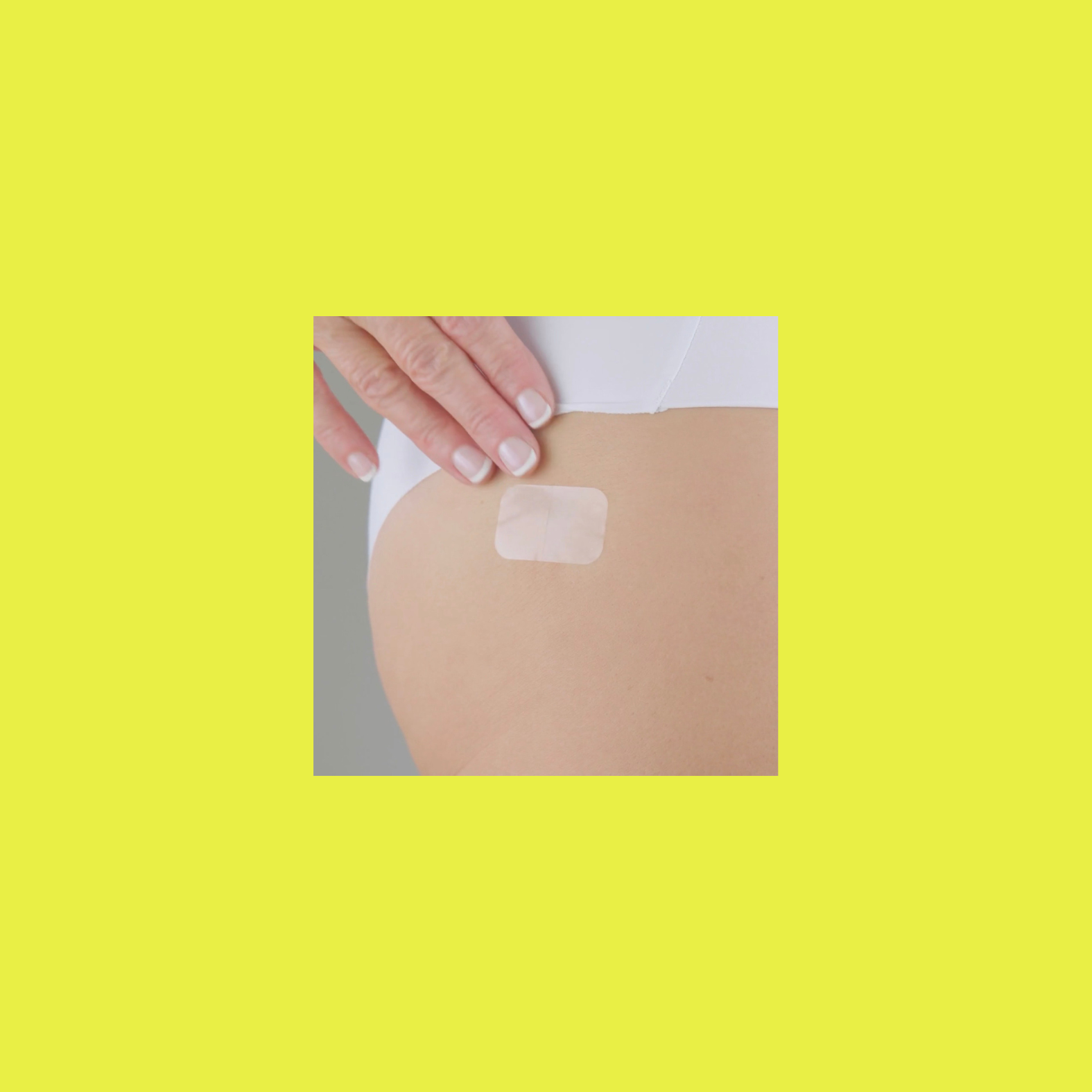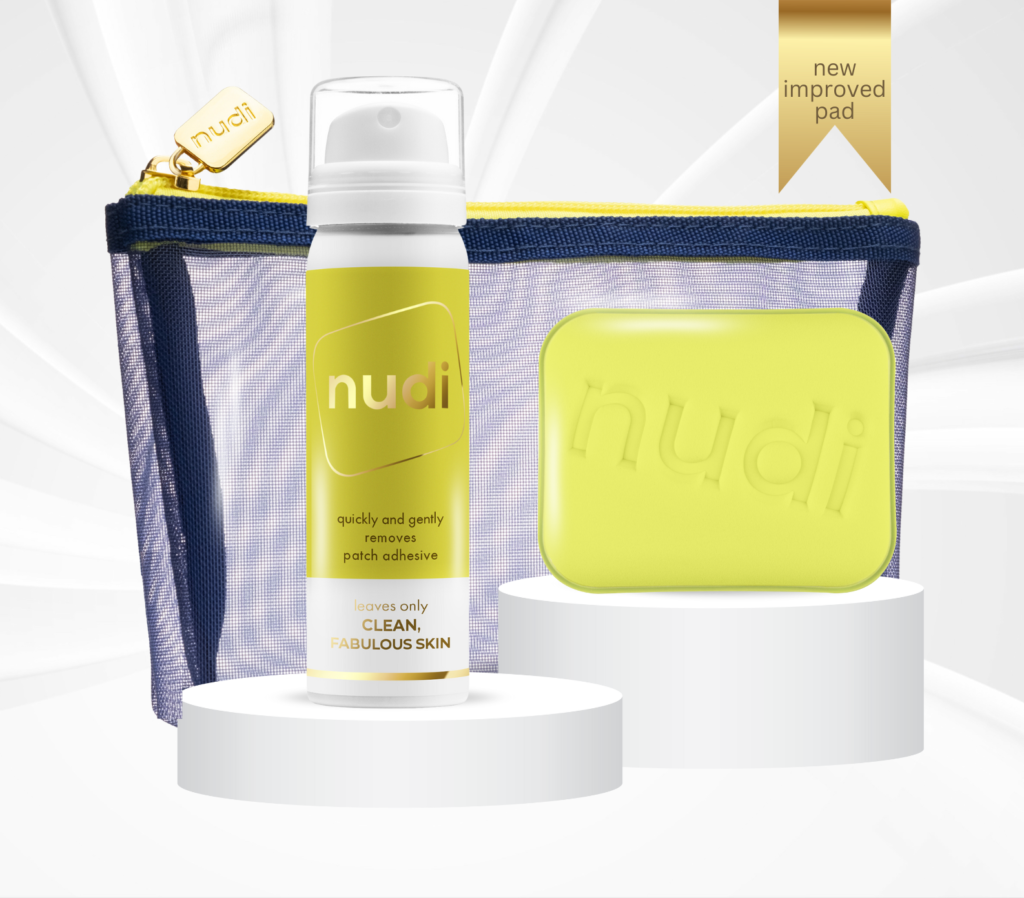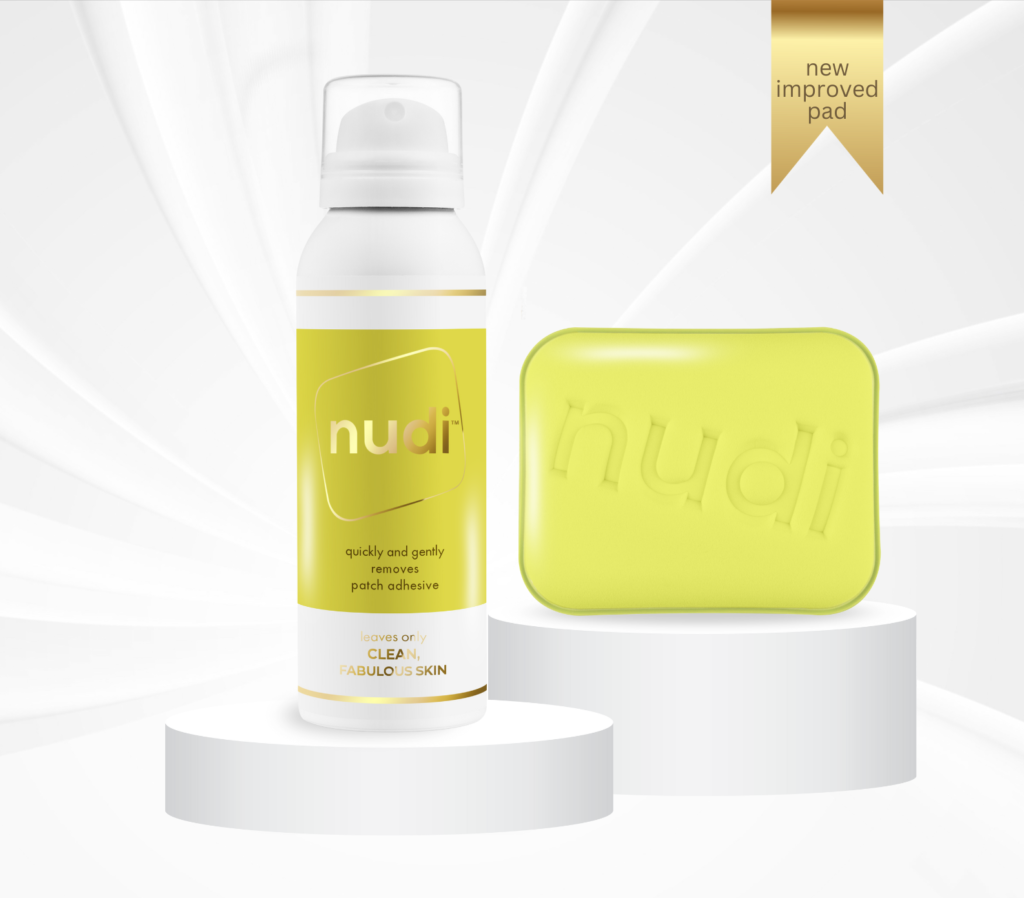
Hormone Replacement Therapy (HRT) is one of the most effective ways to manage the symptoms of menopause and hormonal imbalance. One popular option within HRT is the oestrogen patch, also known as a hormone replacement therapy patch. These patches are designed to deliver a controlled dose of oestrogen through the skin, offering a convenient and effective alternative to pills.
This blog explores the benefits and risks of oestrogen patches, how to use them correctly, how to manage common side effects, and how skincare solutions like Nudi Spray™ adhesive remover with added Vitamin E can improve comfort and skin health. Whether you’re new to HRT or looking to optimise your current treatment, this comprehensive guide will help you make informed choices.
What Are Oestrogen Patches?
Oestrogen patches are medicated transdermal patches worn on the skin. They are a form of transdermal oestrogen therapy, meaning the hormone is absorbed directly through the skin into the bloodstream. This method bypasses the digestive system and offers a steady, controlled hormone release over time.
Oestrogen patches are commonly used in menopause hormone treatment to manage symptoms such as:
- Hot flushes
- Night sweats
- Mood swings
- Vaginal dryness
- Sleep disturbances
- Fatigue
- Loss of bone density (osteoporosis prevention)
There are two main types of patches:
- Oestrogen-only patches (for women who have had a hysterectomy)
- Combined oestrogen and progesterone patches (for women with a uterus, to reduce the risk of endometrial cancer)
The best oestrogen patch for menopause varies from person to person. It depends on your symptoms, medical history, lifestyle, and preferences. Your doctor or healthcare professional can help you decide which form is most suitable.
Estrogen Patch vs. Pill. Which Is Better?
One of the most common comparisons in HRT is estrogen patch vs. pill. While both deliver the same hormone, how they work in the body differs significantly.
Pills pass through the digestive system and liver before reaching the bloodstream. This process, known as first-pass metabolism, may increase the risk of certain side effects, such as blood clots.
In contrast, hormone replacement therapy patches provide estrogen absorption through skin, delivering the hormone directly into the bloodstream without liver processing. This offers several advantages:
- Lower risk of blood clots
- Fewer fluctuations in hormone levels
- More consistent symptom control
- Better suited for women with digestive issues
Who Can Benefit from Oestrogen Patches?
Oestrogen patches are recommended for a wide range of individuals, including:
- Women in natural menopause
- Women experiencing early menopause or Premature Ovarian Insufficiency (POI)
- Those with hormonal imbalance due to surgery (e.g., oophorectomy or hysterectomy)
- Women who prefer not to take pills or who cannot tolerate oral HRT
Patches can be highly effective in reducing symptoms such as hot flushes, mood swings, vaginal discomfort, and poor sleep quality. They may also help prevent bone loss and improve overall quality of life.
How to Use Oestrogen Patches Correctly
Proper HRT patch usage is essential to get the most benefit from your treatment and reduce potential side effects.
How to Apply an HRT Patch
Learning how to apply an HRT patch correctly is key to ensuring proper hormone delivery.
Follow these simple steps:
- Choose the right site: Apply the patch to your lower abdomen or buttocks. Avoid breasts or areas with cuts, rashes, or irritation.
- Clean the skin: Ensure the area is clean and dry. Don’t use oils, lotions, or powders beforehand.
- Peel and press: Remove the protective backing and press the patch onto your skin. Hold firmly for 10-15 seconds.
- Wash your hands: After application, always wash your hands thoroughly.
- Avoid direct heat: Don’t place patches near heating pads or hot water bottles, as heat can increase hormone release.
Rotating HRT Patch Application Sites
Rotating HRT patch application sites is crucial for maintaining healthy skin and reducing skin irritation from hormone patches. Repeated use on the same area can cause redness, itching, or even adhesive allergies from patches.
- Rotate application sites each time you apply a new patch.
- Avoid using the same spot within a seven-day period.
- If you notice irritation, switch to a new area immediately.
How Often to Replace the Patch
Most patches are changed once or twice a week, depending on the brand and dosage. Always follow the schedule given by your doctor. Set calendar reminders if needed to stay consistent.
If a patch falls off, apply a new one on a different site and continue your usual replacement schedule.
Can You Shower with a Patch?
Yes, most patches are designed to be water-resistant oestrogen patches, so you can safely bathe or shower without them falling off. However, avoid excessive rubbing or long hot baths that might affect adhesion.
If you’re worried about patch security during water activities, consider using skin-safe adhesive covers or medical tape.
Common Side Effects of Oestrogen Patches
While oestrogen patches are generally safe, some users experience mild to moderate side effects. Understanding these can help with Managing HRT side effects early and effectively.
Common Symptoms Include:
- Skin irritation or redness
- Breast tenderness from HRT
- Headaches from hormone therapy
- Nausea or bloating
- Mood changes
- Fluid retention
Most of these symptoms ease over time as your body adjusts. However, always consult your healthcare professional if symptoms persist or worsen.
Managing and Reducing Side Effects
You don’t need to suffer through discomfort. There are several strategies to help reduce or prevent side effects from hormone replacement therapy HRT:
- Use gentle skin care products like Vitamin E for skin healing.
- Avoid applying patches to broken or irritated skin.
- Rotate your application sites frequently.
- Consider patch testing if allergic reactions occur.
Using Nudi Spray™ for Skin Comfort
Nudi Spray™ adhesive remover is a game-changer for anyone experiencing medical adhesive residue removal issues.
Nudi Spray adhesive remover benefits
- Gently removes sticky residue without harsh rubbing
- Infused with Vitamin E
- Hypo Allergenic
- Scent Free
- Oil Free
- Keeps skin clean and nourished between patch changes
Regular use can make HRT patch usage more comfortable and help prevent long-term skin issues, especially for those with sensitive or menopausal skin.
When to Talk to Your Doctor
It’s important to know when side effects go beyond normal adjustment symptoms. Talk to your doctor if you notice:
- Heavy or unexpected vaginal bleeding
- Signs of blood clots (e.g., swelling, pain in the leg)
- Chest pain or breathlessness
- Yellowing of the skin or eyes
- Severe migraines
Also, ensure your medical history and risk factors are reviewed regularly. Annual checkups, mammograms, and blood pressure monitoring are essential when using menopause hormone treatment long term.
Optimising Skincare for Menopausal Skin
Menopausal skin becomes thinner and more sensitive due to declining hormone levels. Consider incorporating the best skincare for menopausal skin in your daily routine:
- Use fragrance-free moisturisers
- Apply Vitamin E-enriched lotions
- Protect the skin from sun exposure
- Stay hydrated and eat skin-supportive foods
Caring for your skin can make your overall hormone replacement therapy HRT experience more comfortable.
Oestrogen patches offer an effective and convenient form of hormone replacement therapy, helping women manage menopause symptoms and maintain their overall well-being. With correct HRT patch usage, proper site rotation, and good skincare habits, most women can experience significant symptom relief.
Adding tools like Nudi Spray™ and Vitamin E skincare can further enhance comfort and skin health, making it easier to stick with your treatment plan.
Always consult your healthcare professional and talk to your doctor before making changes to your HRT routine.
FAQs
1. How often should I change my oestrogen patch?
Most are changed once or twice weekly depending on the brand and dosage.
2. Can I shower or swim with a patch on?
Yes, most are water-resistant oestrogen patches, but secure the edges well to avoid peeling.
3. What should I do if my patch falls off?
Apply a new patch to a different site and continue your regular schedule.
4. How can I reduce skin irritation from patches?
Rotate sites, avoid irritated areas, and use Nudi Spray™ adhesive remover to clean the skin gently.
5. What are the alternatives to patches?
You can use oral tablets, gels, sprays, or vaginal HRT options. Your doctor will guide you.
Our Products

Adhesive Remover Starter Kit
Designed to remove the most stubborn patch or tape glue from all skin types in a neat travel sized pack .
- Nudi Spray™ 50ml
- Easi Pad™
- Nudi™ Patch Bag
£15

Glue Free Forever!
Subscribe & Save
Enjoy our great value subscription direct to your door without giving glue another thought.
- Nudi Spray™ 100ml
- Easi Pad™
- Cancel anytime
£16

Top Up!
Designed to remove the most stubborn patch or tape glue from all skin types in our larger 100ml can.
- Best Seller
- Nudi Spray™ 100ml
- Easi Pad™
